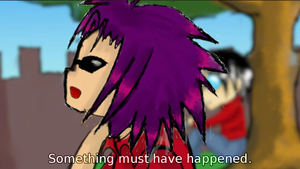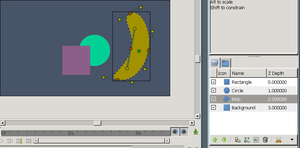Overview
| Language: |
English • čeština • Deutsch • español • suomi • français • Bahasa Indonesia • italiano • 日本語 • Nederlands • polski • português • română • русский • српски / srpski • 中文(中国大陆) |
Animation is the rapid display of a sequence of images ("frames") to create the illusion of movement. Convincing movement requires many such frames, but 2D animation is traditionally created by drawing each frame individually, a method called "frame-by-frame animation".
Digital animation makes it easier for artists to animate more quickly, efficiently, and consistently. It introduced concepts such as automatic in-betweening ("tweening") of frames and reuse of small animations. Synfig Studio is free, open source, 2D animation software that implements those concepts.
Contents
Layers are Different
The Layer in Synfig is a different structure than in most 2D vector editors. Every object, be it a rectangle, circle, bezier outline or region is a layer on its own. The properties of layers control how they look.
The Power of ValueNodes
Synfig's ValueNode system gives us flexible control over repeated data and complex relationships. All layer properties are stored as reusable ValueNodes, which can be linked to each other or even derived mathematic formulae. An important aspect of ValueNodes is that they can be animated and tweened; in fact, the vertices of a shape are ValueNodes, and tweening them morphs the shape.
A feasible example of ValueNodes' capabilities is clothing. If a character's clothing must be colored alike in multiple shots, their colors can be linked across files. Whenever one instance's color is changed, they are all changed instantly.
Aside from linking simple pieces of data, you can also define relations between them using a functions and conditions. The artist has the ability to create automatic animation based on defined laws and brings the whole animation process to a new level. A ball from a cannon can be realistically fired, or a pseudo-3D character's face can rotate accurately with its head.
Possible Animation Types
Morphing
Morphing takes two images and creates a smooth transition between them. This is done by tweening the vertices of one shape to the vertices of another. Intricate nimation with this method is done simply by supplying frames in key positions (keyframes) at relatively wide time intervals, and allowing Synfig to fill in the gaps.
Cutout

Cutout animation is created by splitting objects into parts and applying some simple transformations to them (like translation, rotation or scale) at different points in time. Synfig Studio uses those values to interpolate the motion for in-between frames. Cutout animation can be produced from both bitmap images and vector graphics.
Synfig Studio's features are covered in detail within this manual.
